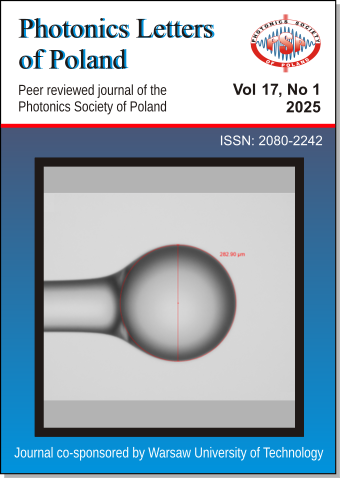Europium-Doped Nanocomposite TiOx:SiOy Layers
DOI:
https://doi.org/10.4302/plp.v17i1.1313Abstract
The work presents TiOx:SiOy nanocomposite layers doped with Eu3+ions. Layers were fabricated using the sol-gel method and dip-coating technique. It was shown that the viscosity of sols and the size of optical band gaps increase with increasing concentration of europium ions. Considering the quantum size effect, it was found that the presence of europium ions causes a weakening of the crystallization of titanium oxide. This means that the diameters of scattering centers are smaller and the layer’s surfaces have lower roughness. In this way, the presence of europium ions in TiOx:SiOy waveguide layers contributes to reducing optical losses in the latter.
Full Text: PDF
References
- B. Zheng et.al. "Rare-Earth Doping in Nanostructured Inorganic Materials", Chemical Reviews , 122(6), 5519 (2022). CrossRef
- R.G Manju et.al. "pectroscopic analysis of Eu3+ doped silica–titania–polydimethylsiloxane hybrid ORMOSILs", RSC Adv., 10, 20057 (2020). CrossRef
- V. P. Prakashan et.al., "Perceiving impressive optical properties of ternary SiO2-TiO2-ZrO2:Eu3+ sol-gel glasses with high reluctance for concentration quenching: An experimental approach", J. Non-Cryst. Solids, 482, 116 (2018). CrossRef
- X. Chen et.al., "Titanium Dioxide Nanomaterials: Synthesis, Properties, Modifications, and Applications", Chem. Rev., 107, 2891 (2007) CrossRef
- L.H Slooff et.al., "Effects of heat treatment and concentration on the luminescence properties of erbium-doped silica sol–gel films", J. Non Cryst. Solids, 296(3), 158 (2001). CrossRef
- M. Zięba et.al. "High Refractive Index Silica-Titania Films Fabricated via the Sol–Gel Method and Dip-Coating Technique—Physical and Chemical Characterization", Materials, 14, 7125 (2021). CrossRef
- P. Karasiński et.al. "Optical rib waveguides based on sol-gel derived silica–titania films", Thin Solid Films, 519, 5544 (2011). CrossRef
- J. Puetz et.al., Dip Coating Technique. In: Aegerter M.A., Mennig M. (eds) Sol-Gel Technologies for Glass Producers and Users. 2004 Springer, Boston, MA. CrossRef
- C.J. Brinker, G.W. Scherer, Sol-Gel Science: The Physics and Chemistry of Sol-Gel Processing; Wiley & Sons Library: Hoboken, NJ, USA, (2013). CrossRef
- P. Karasiński, M. Zięba, E. Gondek, J. Nizioł, S. Gorantla, K. Rola, A. Bachmatiuk, C. Tyszkiewicz, "Sol-Gel Derived Silica-Titania Waveguide Films for Applications in Evanescent Wave Sensors—Comprehensive Study", Materials, 15, 7641 (2022). CrossRef
- P. Karasiński, E. Gondek, S. Drewniak, I.V. Kityk, "Nano-sized blue spectral shift in sol–gel derived mesoporous titania films", J. Sol-Gel Sci. Technol., 61, 355 (2012). CrossRef
Downloads
Published
How to Cite
Issue
Section
License
Copyright (c) 2025 Magdalena Zięba, Cuma Tyszkiewicz, Paweł Karasiński

This work is licensed under a Creative Commons Attribution 4.0 International License.
Authors retain copyright and grant the journal right of first publication with the work simultaneously licensed under a Creative Commons Attribution License that allows others to share the work with an acknowledgement of the work's authorship and initial publication in this journal. Authors are able to enter into separate, additional contractual arrangements for the non-exclusive distribution of the journal's published version of the work (e.g., post it to an institutional repository or publish it in a book), with an acknowledgement of its initial publication in this journal. Authors are permitted and encouraged to post their work online (e.g., in institutional repositories or on their website) prior to and during the submission process, as it can lead to productive exchanges, as well as earlier and greater citation of published work (See The Effect of Open Access).




